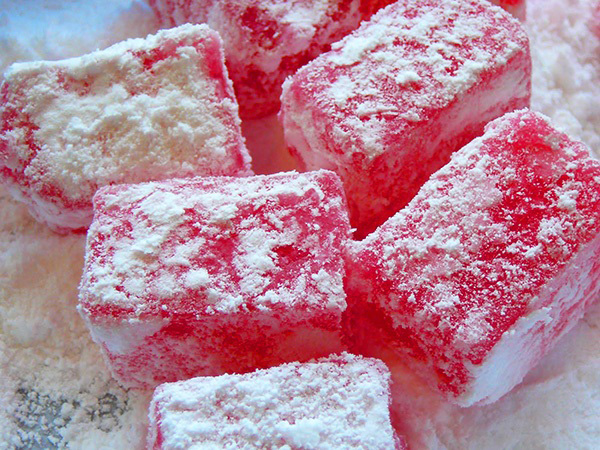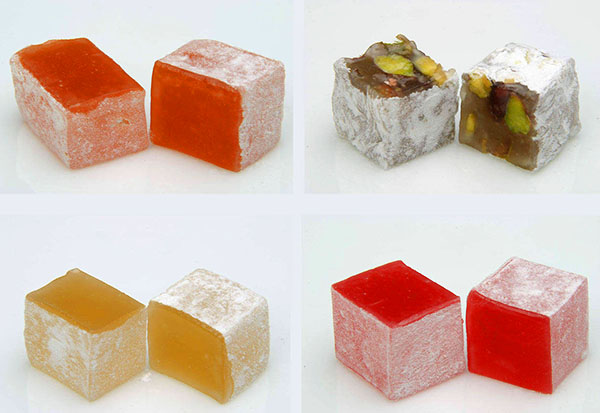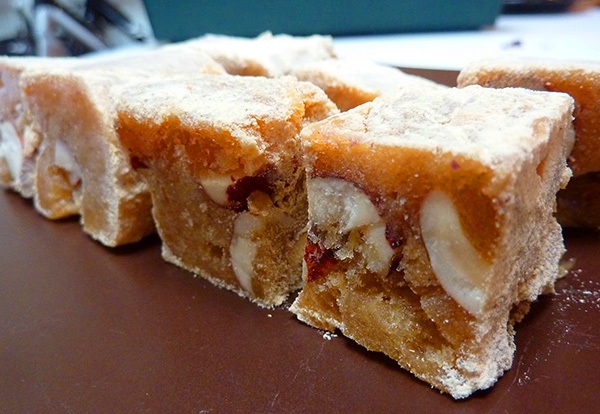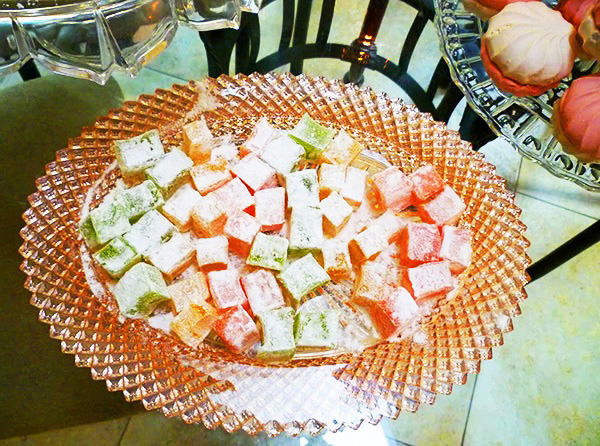

Chapter:
Oriental sweets
2nd page of the section
These desserts are airy and literally melt in your mouth, and therefore will please the most picky sweet tooth.
FROM THE HISTORY
Turkish delight (a modified Arabic name meaning “sweetness for the throat”) is one of the most famous oriental delicacies. In the West, it received the eloquent name “Turkish Delight”. (Turkish Delight - colorful boxes with such inscriptions are sold everywhere, both in Turkey and in European supermarkets.) The Turks themselves call these fragrant soft candies “lokum”.
The Turkish delight recipe was compiled by the Turkish confectioner Ali Mahiddin Bekir at the end of the 18th century. He allegedly set to work at the request of the Sultan, who was tired of gnawing on hard sweets.
According to another version, the Sultan ordered the best confectioners of the Ottoman Empire to prepare a new dessert to please his many wives.
As a result of culinary experiments, a soft, delicate delicacy appeared, the preparation of which is not difficult, but requires a certain patience. Ali Mahiddin mixed hot sugar syrup with starch dissolved in water and poured the resulting mixture into a flat mold greased with oil. After waiting for the viscous mass to harden, Ali Mahiddin cut it into pieces and sprinkled it with powdered sugar.
A simple recipe, as often happens, became the basis for further experiments. To please different tastes, honey, almonds, hazelnuts, pistachios, cinnamon, lemon zest, fruit and chocolate were added to Turkish Delight.
Modern confectioners, who are sensitive to tradition, try to use only rose water in preparing the delicacy, as in the original recipe.
Ali Mahiddin became widely known in the Turkish capital. He opened a small shop in the center of Istanbul, which is still owned by his descendants.
Turkish delight quickly gained popularity and was sold throughout the Ottoman Empire and beyond. It has become a familiar component of the cuisine of Balkan and Middle Eastern countries.
In the 19th century, it was brought to Western Europe, where the Turkish delicacy, perfect for tea, was especially loved by the British.
TECHNOLOGICAL CRAFT
To prevent Turkish delight from getting soggy during storage, it is first rolled in starch and then in powdered sugar.



TURKEY LOKUM CITRUS
Ingredients
:
5 cups sugar, 2 cups water, 1/2 cup starch, zest from 1 orange or lemon, 2-3 drops lemon or orange oil, 4-5 tbsp. spoons of powdered sugar.
Preparation
Dilute the starch with 1 glass of cold water and stir well so that there are no lumps. Pour sugar into a saucepan with the remaining water, stirring occasionally, bring to a boil and cook over medium heat for 15-20 minutes.
After this, with the sugar syrup boiling strongly, pour in the starch solution, reduce the heat, add finely grated lemon or orange zest and, stirring continuously, cook until the mass thickens.
When the Turkish delight comes away from the sides of the dish, add citrus oil, mix again and place the dish on a baking sheet lined with parchment paper or in molds, smooth the surface, pressing it down with a wet spoon, and let cool for 4-5 hours.
Cut the finished dessert into squares, roll in powdered sugar and serve, placing in a vase.
TURKEY LOKUM ALMOND
Ingredients
:
3 cups sugar, 6 cups water, 3 cups starch, 1/2 cup peeled almonds, 1/2 cup powdered sugar.
Preparation
Divide the shelled almonds into halves. Dilute the starch with cold water (3 cups), stir so that there are no lumps, and leave for a while.
Pour sugar into the pan, pour in the remaining water and, stirring occasionally, bring to a boil, skimming off the foam. After this, pour in the starch solution, stirring quickly, add almonds and, stirring continuously, boil until the mixture thickens.
Then place the Turkish delight on a tray with high sides or on a baking sheet, form a rectangular layer 2-2.5 cm thick with hands moistened with cold water or a spoon and let it harden.
After this, cut the Turkish delight into small pieces, roll in powdered sugar, place in a vase or on a plate and serve.
STUFFED TURKISH LOKUM
Ingredients
:
4 cups sugar, 4 cups water, 3 tbsp. tablespoons starch, 1/4 teaspoon cinnamon, 1 cup peeled almonds, 1/2-1 cup powdered sugar.
Preparation
Almonds (you can replace them with hazelnuts or roasted and peeled peanuts) are strung on threads 15-20 cm long, tying a match to the lower end of the thread to hold the nuts. Pour the starch into 1 glass of cold water, stir and leave for a while.
Pour sugar into a saucepan with water and boil the water over high heat, removing the foam if necessary, then, stirring continuously, pour in the starch solution and continue cooking until the mass begins to pull away from the walls of the dish. Then place the pan in a water bath so that the Turkish delight remains warm all the time, lower the nuts strung on threads into it one by one, immediately remove and wait until the mass hardens on them.
Repeat this procedure several times, increasing the layer of Turkish delight to the desired thickness (the Turkish delight in the pan should remain warm).
Leave the stuffed lokum for several hours so that it is completely dry, and then carefully, holding a match, pull out the threads.
Roll the resulting pieces in powdered sugar, place on a plate or in a vase and serve as a dessert.
TURKISH LOKUM VANILLA
Ingredients
:
1 cup sugar, 1 cup water, 1 cup cornstarch, 1 cup powdered sugar, 1/5 teaspoon vanilla, citric acid on the tip of a knife.
Preparation
Mix sugar with water, prepare syrup (to improve the gelling process, you can add a little gelatin to it), add starch to it and boil, adding citric acid and vanillin at the end.
After cooking, pour the resulting cooled mass into trays lined with parchment paper, let the mass thicken and after 4 hours cut into rectangular pieces, roll them in powdered sugar and place in a dry cardboard box.
To add color and taste to Turkish delight, you can add a little fruit juice or syrup.
TARGET LOKUM “ASSORTED”
Ingredients
:
4 cups sugar, 1 liter of water, 100 g rice, wheat or corn starch, 3-4 tbsp. spoons of fruit syrup, 1/2 cup of any peeled nuts, 2 teaspoons of lemon or orange zest, 1/4 teaspoon of saffron or turmeric, 1 bag of vanilla sugar, 100 g of powdered sugar.
Preparation
Prepare the nuts: cut walnuts into quarters, roasted and peeled peanuts and almonds into halves. Dissolve starch in a glass of cold water. Pour the remaining water into a copper basin, add sugar and cook, skimming off the foam, until the syrup becomes clear.
After this, at a high boil, pour in the starch solution and, stirring continuously with a wooden spoon, cook over low heat until thickened. Then, without stopping stirring, add fruit syrup, saffron or turmeric, nuts and zest one by one and continue cooking until semi-solid, stirring all the time so that the Turkish delight does not burn.
After this, place it on a baking sheet or tray in a layer of 2-2.5 cm and cool for 3-4 hours.
Serve in a bowl, cut into square pieces and sprinkle with a mixture of vanilla and powdered sugar.
TURKEY LOKUM RICE
Ingredients
:
1 half glass of rice, 1 liter of water, 3 glasses of sugar, 1 glass of orange, apricot or peach juice, 1 glass of powdered sugar.
Preparation
Rinse the rice, dry it, add it to a pan of boiling water and cook until the grain is completely boiled. Pour the juice into another bowl, add sugar, stir and cook, stirring constantly and skimming off the foam, for 40 minutes until it becomes a “thin thread”.
Rub the rice cooked to a paste through a sieve, combine with the fruit syrup and, stirring continuously, continue to cook over low heat until the mass pulls away from the walls of the dish.
After the Turkish delight has cooled a little, place it on a board or baking sheet in the form of a finger-thick layer, smooth the edges, sprinkle generously with powdered sugar on top and leave for 24 hours to harden.
Cut the finished Turkish delight into squares, roll them in powdered sugar and serve in a vase.
TURKISH LOKUM “ROSE OF THE EAST”
Ingredients
:
3 tbsp. tablespoons starch, 4 cups water, 4 cups sugar, 2 tbsp. spoons of cherry or raspberry syrup, 1-2 drops of rose oil, 20 g of butter or margarine, 1/2 cup of powdered sugar.
Preparation
Pour cold water (1 cup) over the starch, stir and set aside. Pour sugar into a saucepan with water and bring the sugar syrup to a boil over high heat, periodically skimming off the foam. Then, stirring continuously, pour in the starch solution and continue cooking until the mass begins to pull away from the walls of the dish.
After this, remove the Turkish delight from the heat, add cherry or raspberry syrup and rose oil, mix well, place on a baking sheet greased with butter, form into a rectangular layer 2-3 cm thick and leave for 3-4 hours in a cool place.
When the Turkish delight has hardened, cut it into small pieces, roll them in powdered sugar, place in a vase and serve with tea.
SHAKER-LOKUM
Ingredients
:
1.5 cups wheat flour, 4 tbsp. tablespoons melted butter, 2/3 cup powdered sugar, 2 egg yolks, 1 tbsp. spoon of cognac, 1/4 teaspoon of saffron.
Preparation
Pour cognac over saffron and stir. Grind the melted butter until white. Grind raw yolks with powdered sugar, add melted butter and cognac with saffron, mix well, add sifted flour and knead the dough. Place it in the refrigerator for 7-10 minutes, then form balls the size of walnuts and flatten them slightly to form thick cakes.
Place them on a baking sheet, place in a preheated oven and bake over low heat for 7-10 minutes.
Place the finished products on a dish or plate and serve with tea.

It turns out that 100 years ago there was already a problem with food additives and artificial colors and their replacement of natural ingredients. So really - “there is nothing new under the sun.”
The necessary utensils for preparing Turkish delight can always be found in any household and boils down to a simple enamel cauldron, which can be replaced with a brass jam basin. In addition, you also need some kind of vessel for diluting starch and a thin hair (so-called silk) sieve for sifting powdered sugar. Finally, to make real fruit Turkish delight, a second hair sieve is used, woven into a double thread and distinguished by its strength. If the product is produced in large quantities for industrial purposes, then for wiping the fruit mass it is more profitable to buy a wiping machine, which significantly speeds up and facilitates the work. Finally, for pouring out sheet Turkish delight, tin sheets with edges are also used, which should not be used for other purposes, especially for frying.
As for the components used in the above production, they come down to the following products.
Starch: The main condition for obtaining good, transparent Turkish delight is to use the purest wheat starch. Real wheat starch, examined under a microscope, appears in the form of small grains bound together by gluten. To the naked eye, it appears in the form of elongated prismatic columns with sharp edges (radiant or crystalline starch) or in the form of irregularly shaped pieces. The latter type contains a slightly larger amount of gluten, and therefore is especially suitable for the purposes of interest to us. A very good product is also obtained from rice starch, but the cheapest is made from potato starch.
Sugar: the head, of the highest quality, is used, part of it is turned into the smallest powder and sifted through a silk sieve. Reserves of fine sugar should be kept in a tin or bottle with a ground-in stopper, making sure that they do not get soggy.
To flavor Turkish delight of the highest grades, various types of fruit purees are used, rubbed through a sieve. Very hard fruits require preliminary softening by dissolving in water. In the middle varieties there is no puree at all; they are replaced entirely with aromatic fruit essences and essential oils, and the Turkish delight has to be slightly tinted with harmless confectionery colors. All these formulations can be purchased at large pharmacy stores. The best types of paint are French, from the Breton plant, which have significant concentration and are therefore the cheapest. The most commonly used red paint can also be made at home, for which you should buy 4 parts of cochineal and grind it in a porcelain mortar with 1 part by weight of tartaric acid and dilute everything gradually with 60 parts of filtration water. Then everything is boiled thoroughly and stored in a tightly sealed bottle.
For the filling of Turkish delight, peeled almonds are used, and for some varieties - peeled nuts or pistachios, strung like a rosary on strong linen threads. Before consumption, fruits should be carefully sorted, smaller ones should be selected from larger ones, and each size should be strung separately. Both almonds and pistachios should be immersed in cold water immediately after peeling to prevent them from turning black.
Finally, it is recommended to add at least a small amount of traganth gum or gelatin to the highest grades of Turkish delight. If you prepare the product using starch alone, you would have to brew the mass too thickly, which would inevitably affect the tenderness of the finished Turkish delight; gum and gelatin give it a certain lightness, especially appreciated by amateurs. Both of these glues are diluted until smooth in water and poured into the welded mass.
As for the process of making Turkish delight, it is as follows: after weighing out the required amount of starch (about 5 lots), pour it with 2 glasses of cold water and let it stand for a while. Then boil the syrup from 2 glasses of water and 2 pounds of sugar, thoroughly clear it of foam, and when the syrup becomes completely transparent, then pour starch diluted until smooth, stirring constantly. When the mass has boiled down so much that it lags behind the edges and walls of the vessel, remove it from the heat, add colors and aromas, knead thoroughly until smooth and pour it onto the prepared sheet, after which it is taken out into the cold. When the mass has thoroughly cooled and hardened, it is cut into pieces and carefully rolled in powdered sugar.
Stuffed Turkish delight is molded somewhat differently.
The mass here is cooked somewhat thinner, the cauldron with it is placed in another vessel with boiling water so that it remains warm all the time. Threads with strung almonds are lowered into the mass one by one and they are immediately suspended until the mass hardens on them. Then, the remaining mass is heated, gently stirred and the threads with almonds are lowered into it again. This is repeated until the Turkish delight acquires the proper thickness, then it is allowed to dry thoroughly and, carefully pulling the thread from the middle, the resulting cylindrical pieces are rolled in powdered sugar.
Here are some tried and tested recipes for making Turkish Delight.
APPLE TURKEY LOKUM:
Take 2 pounds of Antonov apples, cut them into circles with the skin, add half a pound of sugar, a few tablespoons of water, simmer in a saucepan under a lid, rub through a sieve. Separately, boil syrup from 2 pounds of sugar and 1 bottle of water, add applesauce and season with all 5 lots of rice or wheat starch, boil to the desired thickness. You can take only 4 lots of starch and add a few leaves of dissolved gelatin. After removing the mass from the heat, pour 2-3 drops of lemon oil into it if desired and proceed further as explained above. This Turkish delight is not tinted with anything. Products made from black currants, apricots, etc. are cooked in exactly the same way.
STRAWBERRY AND RASPBERRY TURKEY LOKUM:
It is prepared according to the previous recipe, but the berries are not shaded, but pureed raw. The mass requires a light tinting of red with a cochineal solution.
ALMOND TURKEY LOKUM
It is prepared like the previous ones, but no fruit mass is placed in it; the mass is flavored after cooking with a few drops of bitter almond oil. This addition must be done with great caution, because due to the hydrocyanic acid it contains, the oil can be a strong poison. Therefore, it is necessary to buy exclusively only the most expensive variety of it, and, moreover, in stores that are completely trustworthy, on which you can completely rely that they will provide a well-purified product.
In exactly the same way, vanilla (tinted pale pink), lemon (tinted yellow with saffron) and pink Turkish delight are prepared, and the corresponding oils and essential essences are added. Finally, using the same recipe, you can prepare all commercial varieties of Turkish delight with the aroma of various fruits and berries, and they are tinted in the appropriate colors.
You should be especially careful when sprinkling the mixture with fine sugar, as otherwise it will stretch and stick to your fingers and to the bottom of the box. Usually the sprinkled pieces of Turkish delight are allowed to stand for several days in a warm room, and then they are again rolled in sugar and stored.
TURKISH DELIGHT
In a tinned copper bowl with a convex bottom, sugar and water (1/2 liter) are heated to a boil. Wheat or maize (corn) starch is diluted in cold water (1/2 l). Separately, a cremortator (white powder that protects against crystallization; sold in a pharmacy) is diluted in cold water (1/4 cup). When the sugar syrup boils, add cold water (1/2 l), diluted cremortizer, starch, stirring along the bottom of the dish with a wooden spatula. This mixture, without ceasing to stir, is boiled to a semi-solid state, fruit reserves or candied fruits, vanilla or essence are added to it, painted over with food paint, thoroughly kneaded and placed on a wooden tray or sheet, cooled, then cut into small rectangles.
For 1 kg of granulated sugar - 150 g of starch, 3 g of cremortator, 20 g of candied fruits or fruit reserves, 1/2 g of vanilla, 20 drops of essence.
TURKISH DELIGHT
For the syrup: 1 kg sugar, 300 g water.
For starch milk: 100 g rice, wheat or corn starch, 200 g cold boiled water.
For topping the Turkish Delight: 100 g of powdered sugar, 1 cm of vanilla stick or a bag of vanilla sugar.
To cook Turkish delight: 3-4 tbsp. spoons of jam syrup or fruit puree, 2 teaspoons of lemon or orange zest, 1 drop of rose oil or 1 teaspoon of rose syrup (see above), 100 g of peeled nuts (almonds, hazelnuts), 1 pinch of saffron or turmeric.
Preparation:
1. Boil sugar syrup in a cauldron or copper bowl, pour starch milk (a mixture of water and starch) into it at a high boil and, reducing the heat, stir all the time with a wooden spoon until the mass thickens.
2. Add the remaining ingredients in the following order: fruit puree, spices, rose oil, nuts, agar-agar. Cook until semi-solid, stirring constantly with a spoon along the bottom of the cauldron, not allowing the mixture to burn.
3. Pour the finished mass into a wooden baking sheet in a 2.5 cm layer, let it harden for 3-4 hours, then cut into square pieces and sprinkle with powdered sugar and vanilla.
TURKISH DELIGHT
The name Turkish delight is perhaps no less famous when it comes to oriental sweets than halva. And Turkish delight is no less ancient dish. Like halva, there are many variations of it; like halva, Turkish delight was prepared by special cooks Kandalachi. Most likely, the birthplace of Turkish delight is Türkiye. We invite you to try two versions of Turkish delight: with pistachios and fruit.
For Turkish delight with pistachios, take three and a half glasses of granulated sugar, 1 glass of water, 1 glass of potato starch, 300 - 400 grams of pistachios and a little citric acid. Boil sugar and water, add starch and cook until thickened. Add citric acid at the very end. Let's take a flat mold and pour about half of the pistachios into it, fill it with the resulting mass (in fact, it's called Turkish delight), sprinkle the remaining pistachios on top and let it cool. Turkish delight is served cut into oblong pieces.
For fruit Turkish delight, take again three and a half glasses of granulated sugar, 1 glass of potato starch, 3 tablespoons of powdered sugar, vanillin, citric acid and fruit molasses. Boil sugar with one glass of water, add starch and cook until thickened. At the very end, add fruit syrup, vanillin and citric acid. Then pour the mixture into a flat pan and let it harden. Turkish delight is also served cut into pieces and sprinkled with powdered sugar.